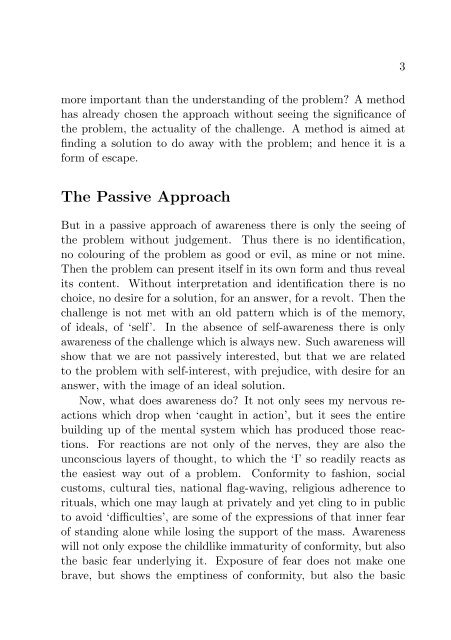Awareness in Buddhist Meditation
A detailed description of awareness in Buddhist Meditation.
A detailed description of awareness in Buddhist Meditation.
You also want an ePaper? Increase the reach of your titles
YUMPU automatically turns print PDFs into web optimized ePapers that Google loves.
3<br />
more important than the understand<strong>in</strong>g of the problem? A method<br />
has already chosen the approach without see<strong>in</strong>g the significance of<br />
the problem, the actuality of the challenge. A method is aimed at<br />
f<strong>in</strong>d<strong>in</strong>g a solution to do away with the problem; and hence it is a<br />
form of escape.<br />
The Passive Approach<br />
But <strong>in</strong> a passive approach of awareness there is only the see<strong>in</strong>g of<br />
the problem without judgement. Thus there is no identification,<br />
no colour<strong>in</strong>g of the problem as good or evil, as m<strong>in</strong>e or not m<strong>in</strong>e.<br />
Then the problem can present itself <strong>in</strong> its own form and thus reveal<br />
its content. Without <strong>in</strong>terpretation and identification there is no<br />
choice, no desire for a solution, for an answer, for a revolt. Then the<br />
challenge is not met with an old pattern which is of the memory,<br />
of ideals, of ‘self’. In the absence of self-awareness there is only<br />
awareness of the challenge which is always new. Such awareness will<br />
show that we are not passively <strong>in</strong>terested, but that we are related<br />
to the problem with self-<strong>in</strong>terest, with prejudice, with desire for an<br />
answer, with the image of an ideal solution.<br />
Now, what does awareness do? It not only sees my nervous reactions<br />
which drop when ‘caught <strong>in</strong> action’, but it sees the entire<br />
build<strong>in</strong>g up of the mental system which has produced those reactions.<br />
For reactions are not only of the nerves, they are also the<br />
unconscious layers of thought, to which the ‘I’ so readily reacts as<br />
the easiest way out of a problem. Conformity to fashion, social<br />
customs, cultural ties, national flag-wav<strong>in</strong>g, religious adherence to<br />
rituals, which one may laugh at privately and yet cl<strong>in</strong>g to <strong>in</strong> public<br />
to avoid ‘difficulties’, are some of the expressions of that <strong>in</strong>ner fear<br />
of stand<strong>in</strong>g alone while los<strong>in</strong>g the support of the mass. <strong>Awareness</strong><br />
will not only expose the childlike immaturity of conformity, but also<br />
the basic fear underly<strong>in</strong>g it. Exposure of fear does not make one<br />
brave, but shows the empt<strong>in</strong>ess of conformity, but also the basic

















